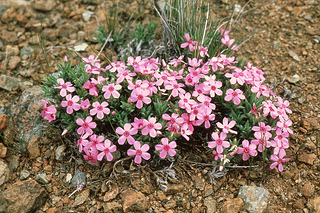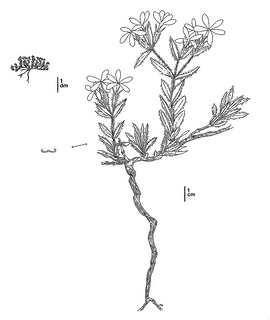(Phlox hirsuta)
 Phlox hirsuta. Photo © CNPS.
Phlox hirsuta. Photo © CNPS.
 Phlox hirsuta. CDFW illustration by Mary Ann Showers. (Click to enlarge)
Phlox hirsuta. CDFW illustration by Mary Ann Showers. (Click to enlarge)
Yreka phlox is a California endangered plant species, which means that killing or possessing this plant is prohibited by the California Endangered Species Act (CESA). This species is also listed as endangered under the federal Endangered Species Act. Yreka phlox is a perennial, low-growing plant in the phlox family (Polemoniaceae) that produces bright rose-pink to white flowers which bloom from April to June. It grows from a woody base, and mature Yreka phlox plants grow approximately two to six inches high and have hairy leaves and stems.
Yreka phlox is only known from the vicinity of Yreka, California in Siskiyou County. It grows in open areas on dry serpentine soils and is found at elevations ranging from 2,700 to 4,400 feet. Associated plant species include western juniper (Juniperus occidentalis), Jeffrey pine (Pinus jeffreyi), ponderosa pine (Pinus ponderosa), incense cedar (Calocedrus decurrens), rubber rabbitbrush (Ericameria nauseosa), and buckbrush (Ceanothus cuneatus). At the time of the U.S. Fish and Wildlife Service’s 5-Year Review conducted in 2007, five occurrences of Yreka phlox were confirmed to exist, and a sixth occurrence was reported to the California Natural Diversity Database in 2011 near Grenada. In addition, the locality information from a single 1930 collection housed at the California Academy of Sciences herbarium in San Francisco indicates a possible historical location in the vicinity of Etna or Echo Mill, near Soap Creek Ridge. Known occurrences of Yreka phlox are located on lands that are owned and managed by industrial timber companies, other private landowners, the U.S. Forest Service, California Department of Transportation, and the City of Yreka.
The U.S. Fish and Wildlife Service completed the Recovery Plan for Phlox hirsuta (Yreka phlox) (PDF) in 2006, and a Spotlight Species Action Plan for the species in 2009. These plans, together with the U.S. Fish and Wildlife Service’s 5-Year Review, identify the primary threats to Yreka phlox as alteration and destruction of habitat resulting from residential development, logging, fire suppression activities, ongoing highway maintenance and construction activities, off-road vehicle use, illegal collection, and vandalism. Other threats identified include competition with exotic plants, herbicide application, grazing by domestic animals, and potential extirpation as a result of random natural events.
Long-term survival of Yreka phlox is dependent upon protecting and securing known occurrences of this species. A monitoring strategy should be developed and implemented for all occurrences that will identify existing and new threats, and a management plan should be implemented at each protected site. A seed bank should be created and maintained and propagation techniques should be developed in case of unforeseen future population losses. Surveys should be conducted for undiscovered occurrences of Yreka phlox, and research should be conducted to guide recovery and conservation efforts. In addition, efforts should focus on enhancing public awareness, understanding and participation in Yreka phlox recovery. Some of these conservation actions are already underway and their progress is described in the U.S. Fish and Wildlife Service’s Recovery Plan Action Status.
CDFW has participated in the following projects related to Yreka phlox with support from the federal Cooperative Endangered Species Conservation Fund, including a project to collect seed for long-term conservation storage.
CDFW may issue permits for Yreka phlox pursuant to CESA, and you can learn more about the California laws protecting Yreka phlox and other California native plants. Populations of Yreka phlox occur in CDFW's Northern Region. More information is also available from the U.S. Fish and Wildlife Service Species Profile for Yreka Phlox.
Updated 9/23/2013